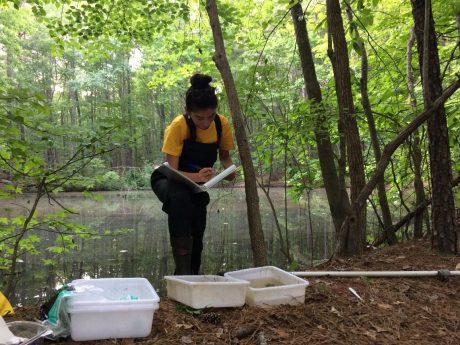
Editor’s note: The following is a guest post by Applied Ecology minor, and Dragonfly Pond Works scholar, April Sharp. You can read about April’s scholarship in her previous blog here.

Working with Dragonfly Pond Works on this project has been a fantastic experience, and I hope that the findings of this study can shed light on areas of future research in the ecology of stormwater ponds and constructed wetlands. For my project, I sampled constructed stormwater ponds located in urban residential areas of Wake county and compared the abundance, diversity, pollution tolerance, and trophic assemblage of sampled macroinvertebrate communities to those found in natural, unmanaged ponds in the surrounding “peri-urban” areas. I also tested the water quality at each pond to try to assess which factors related to urbanization impacted macroinvertebrate community assemblages.
Urban stormwater ponds featured similar taxa richness to the natural ponds; however, natural ponds supported a greater diversity of organisms. In addition, urban stormwater ponds contained a greater abundance of pollution tolerant taxa in comparison to the natural, peri-urban ponds. These findings suggest that macroinvertebrate communities are significantly impacted by urban stressors and surrounding land uses. Not only were community assemblages different between the two pond types, but the ecological roles of urban macroinvertebrate communities varied as well. The urban stormwater ponds contained a higher proportion of predatory taxa to scavengers and primary consumers, while the natural, peri-urban ponds showed the opposite trend. A possible reason for this finding is that the constructed ponds are less stable aquatic ecosystems compared to the natural ponds, as they are less established and experience frequent disturbances. This may result in simpler, less diverse food webs.

Although the macroinvertebrate communities within the stormwater ponds was significantly less diverse than those within the natural ponds, the inverted food web may be a desirable feature in urban and suburban environments. A higher abundance of predators might result in lower populations of undesirable pest species such as mosquitos and midge flies. Since stormwater ponds are a common and important landscape feature for ecology and human wellbeing, management practices should aim to maximize benefits to both. Further research on constructed stormwater ponds is needed to better understand the interactions and tradeoffs between trophic structure and taxa diversity of aquatic macroinvertebrates.
Read April’s full project write-up here.